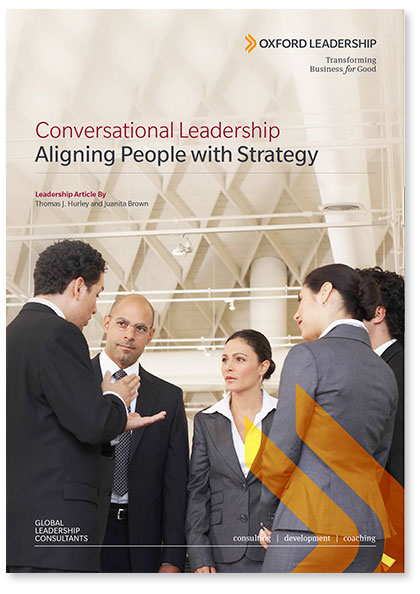Often, it seems that, in the hectic pace of doing business, there’s barely a chance to say “boo” much less reflect on how and why we’re doing what we’re doing.
That conversation-deadening pursuit of efficiency is bad for employees, bad for customers and bad for business performance. What are the leadership practices that foster creative and productive conversations? Conversations and personal relations are at the heart of our work.
After experiencing his first World Café dialogue at a program on self-organizing systems, Bob Veazie had an uncomfortable epiphany. At the time, he was a senior engineer and manufacturing manager at a Hewlett Packard plant in Oregon. In that World Café, Bob experienced how the collective intelligence of a group can become visible as people move from one table to another over several rounds of conversation, cross-pollinating ideas, making unexpected connections, developing new knowledge, and creating action opportunities. Afterward he said:
Something profound but disturbing happened to me during those Café conversations. I realised that the boxes on my organisation chart might more accurately be depicted as webs of conversations.
Each day, we are engaged in conversations about different questions, just like in those table conversations, and we move between the ‘tables’ as we do our work in the company. It hit me with laser-beam clarity: This is how life actually works! So I began to wonder: If our conversations and personal relations are at the heart of our work, how am I, as a leader, contributing to or taking energy away from this natural process? Are we using the intelligence of just a few people when we could gain the intelligence of hundreds or thousands by focusing on key questions and including people more intentionally in the conversation?
Conversation with 50.000 employees
Shortly thereafter, Bob was charged with co-leading a corporation-wide safety initiative that eventually engaged more than 50,000 people in manufacturing plants around the world in conversations about safety risks and how to address them. Meeting people at every level of the company in the settings where they normally gathered, he went in with questions rather than answers and hosted conversations aimed at tapping each group’s own experience, relationships, and mutual intelligence in coming up with better ways to reduce accident rates. His core team took good ideas from one plant to another, shared stories, and brought key people from different levels and parts of the company together to learn from one another. “Each of the employee meetings I attended was like a table in this large, ongoing safety Café—this network of conversations,” Veazie explained. “The ‘tables’ all over the company were connected by the key questions.”
Impressive Results
The outcomes were impressive. In Puerto Rico, the accident rate plummeted from 4.2 percent to 0.2 percent. In Oregon, it fell from 6.2 percent to 1.2 percent. The overall company accident rate was reduced by 33 percent, and these gains were maintained in plants where the safety conversations continued. The shift in how Bob Veazie viewed his organisation prompted a new approach to leadership that dramatically increased HP employees’ collective capacity to achieve their shared aims. He had discovered the power of conversational leadership in action.
Seeing conversation as a core process
As defined by educator Carolyn Baldwin, conversational leadership is “the leader’s intentional use of conversation as a core process to cultivate the collective intelligence needed to create business and social value.” It encompasses a way of seeing, a pattern of thinking, and a set of practices that are particularly important today, when the most important questions we face are complex ones that require us to develop new ways of thinking together to foster positive change.
“The goal of strategic intent is to fold the future back into the present… While strategic intent is clear about ends, it is flexible as to means – it leaves room for improvisation. Achieving strategic intent requires enormous creativity with respect to means.”
Gary Hamel and C.K. Prahaiad
”Strategic Intent” – Harvard Business Review
Spurred by financial crisis and the prospect of an increasingly uncertain future, leaders in all sectors are seeking new ways to leverage organisational and community resources to produce greater strategic impact. Efforts to cut costs, be more efficient, compete more effectively, or innovate have all intensified. Yet many such initiatives fall short of achieving their intended aims or create unintended consequences that require additional interventions.What if increasing the success of these efforts depended on our intentionally focusing on a deeper process — the core process of conversation and meaning-making through which we as human beings have always co-evolved new realities? As evolutionary biologist Humberto Maturana points out, we live in language and the sophisticated coordination of actions that language makes possible. Since our earliest ancestors gathered in circles around the warmth of a fire, talking together has been our primary means for discovering common interests, sharing knowledge, imagining the future, and cooperating to survive and thrive. The natural cross-pollination of relationships, ideas, and meaning as people move from one conversation to others enables us to learn, explore possibilities, and co-create together.

Conversations are action
From this perspective, conversations are action —the very heartbeat and lifeblood of social systems like organisations, communities, and cultures. In all these settings, to use Maturana’s phrase, we “bring forth a world” through the networks of conversation in which we participate. Analytical tools such as social network analysis can help us visualise those networks, while emerging digital technologies and social media such as blogs, wilds, and online communities of practice let us extend, enrich, and deepen conversations and collaboration among an ever-expanding number of participants.
“A leader these days needs to be a host – one who convenes diversity; who convenes all viewpoints in creative processes where our mutual intelligence can come forth.”
Margaret Wheatley
The Berkana Institute
As new possibilities and the coordinated actions based on them start in small groups and then spread through wider networks, we bring the future into being. Conversational leadership takes root when leaders see their organisations as dynamic webs of conversation and consider conversation as a core process for effecting positive systemic change. Taking a strategic approach to this core process can not only grow intellectual and social capital, but also provide a collaborative advantage in our increasingly networked world.
Conversations about questions that matter – the key to break-through process?
How we come together to address critical challenges and opportunities, and the collaborative social technologies we use to think together about key issues, may mean the difference between “business as usual” and the breakthrough thinking and action we need today. By designing, convening, and hosting conversations about questions that matter—and linking those conversations in disciplined ways— leaders have unprecedented opportunities to tap collective intelligence and guide committed action toward the fulfilment of shared purposes. So, instead of admonishing our children at school and employees in organisations to “Stop talking and get to work,” we might be better served to encourage them to “Start talking and create together!”

Download Full Article
Conversational leadership: aligning people with strategy
Download ArticleStay up-to-date with our latest news:
Subscribe








